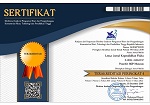IDENTIFIKASI TINGKAT KESULITAN BELAJAR FISIKA POKOK BAHASAN GERAK PADA SISWA KELAS VII SMP NEGERI 13 MATARAM
DOI:
https://doi.org/10.33394/j-lkf.v2i1.307Keywords:
Difficulty Learning Level, MotionAbstract
The study aims to describe the types of learning difficulties and their presentations on the subject of "motion". The sample in this research is the second grade students at secondary high school as much as 2 (two) classes. The data that has been analyzed is the percentage of student error. The results indicated that the types of learning difficulties experienced are: difficulty to understand concepts, reading and understanding graphs, analyzing problems, using formulas, and calculations. The level of learning difficulties on the subject of "motion" from sub-subjects difficult to the easiest are: Straight-Changed Motion (50.64%), velocity and speed (44.01%), Regular Straight Motion (43.87%) and Position and Displacement (35.08%). The average of students' learning difficulty is (43.40%). We conclude that many students have difficulty learning on the subject of Motion.
References
Abdurahman, M. 1999. Pendidikan Bagi Anak Berkesulitan Belajar; Rineka Cipta; Jakarta.
Ali, M. 2000. Guru dalamProses Belajar Mengajar; Sinar Baru Algesindo; Bandung.
Anonim.2003. Kamus Besar Bahasa Indonesia.Balai Pestaka; Jakarta.
Arikunto, S. 2002. Dasar-dasar Evaluasi Pendidikan; Bumi Akasara; Jakarta.
Arikunto, S. 2008. Prosedur Penelitian Suatu Pendekatan Praktek; Rineka Cipta; Jakarta.
Arifin Z. 1999. Evaluasi Instruksional. Rineka Cipta. Jakarta.
BSNP. 2006. Panduan Penyusunan Kurikulum Tingkata Satuan Pendidikan Jenjang Pendidikan Dasar dan Menengah; Depdiknas; Jakarta.
Dajamarah. 2002. Strategi Belajar Mengajar; PT. Adimahasyatiah; jakarta.
Hamalik, O. 2001. Metode Mengajar dan Konsultan Belajar; Sinar Baru Algesindo; Bandung.
Masgono, S. Metodologi Penelitian Pendidikan; Rineka Cipta. Jakarta.
Kanginan, M. IPA Fisika, Erlangga; Cimahi.
Mukhtar. 2003. Pengajaran Remidial; CV. Fifa Mulya Sejahtera; Jakarta.
Mulyono. 2003. Pendidikan Bagi Anak Berkesulitan Belajar; Rineka Cipta. Jakarta.
Nazir. M. Metode Penelitian; Ghalia Indonesia; Darusalam.
Sari, B. N. 2004. Sistem Pembelajaran KBK terhadap Motivasi Belajar Siswa pada Bidang Studi Fisika; Rineka Cipta. Jakarta.
Sugiyono. 2008. Memahami Penelitian Kualitatif; CV. Afabeta. Bandung.
Syah, M. 1999. Psikologi Belajar; PT. Logos Wicana Ilmu; Ciputat.
Tranggono, A. 2004. Sains Fisika; Bumi Aksara; Jakarta.
Downloads
Published
How to Cite
Issue
Section
License
Authors who publish with Lensa: Jurnal Kependidikan Fisika agree to the following terms:
- For all articles published in Lensa: Jurnal Kependidikan Fisika, copyright is retained by the authors. Authors give permission to the publisher to announce the work with conditions. When the manuscript is accepted for publication, the authors agree to automatic transfer of the publishing right to the publisher.
- Authors retain copyright and grant the journal right of first publication with the work simultaneously licensed under a Creative Commons Attribution-ShareAlike 4.0 International License that allows others to share the work with an acknowledgment of the work's authorship and initial publication in this journal.
- Authors are able to enter into separate, additional contractual arrangements for the non-exclusive distribution of the journal's published version of the work (e.g., post it to an institutional repository or publish it in a book), with an acknowledgment of its initial publication in this journal.
- Authors are permitted and encouraged to post their work online (e.g., in institutional repositories or on their website) prior to and during the submission process, as it can lead to productive exchanges, as well as earlier and greater citation of published work (See The Effect of Open Access).

This work is licensed under a Creative Commons Attribution-ShareAlike 4.0 International License.



